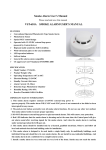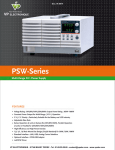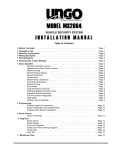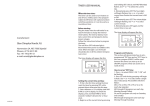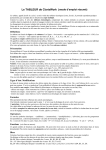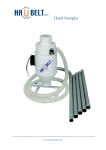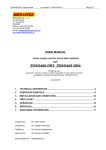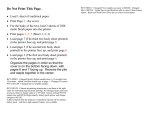Download Datasheet
Transcript
SMOKE SENSOR FT-573 Smoke Alarm User’s Manual Please read and save this manual 1- Specification 1) 110V-240VAC mains power supply 2) Supply voltage DC12 to 30 volts 3) Interconnect up to alarms 4) Photoelectric sensor 5) Two red LED (one of button) indicate alarm 6) Hush feature to silence nuisance alarm 7) Test button 8) Relay contacts-volt free with normally open and normally closed options and rated to 24 volts/1amper resistive 9) High sensitivity 10) Alarm supplied with connector plug for ease of installation built in sounder to give a minimum sound of 85db at 3m smoldering smoke, test button simulates smoke use to check performance at least monthly, option current=10uA, alarm current=30mA 11) 3 years guarantee (limited) IMPORTANT SAFETY INFORMATION 1) This smoke alarm requires constant 12-30V DC power, AC power 110-240 volt. This smoke alarm WILL NOT work if the AC power is not connected or has failed or been interrupted for any reason DO NOT connect this smoke alarm to any other type of smoke alarm or auxiliary device, except those listed in this manual. 2) The test button accurately tests all smoke alarm functions. DO NOT use any other test method. The smoke alarm weekly to ensure proper operation. 3) DO NOT turn off AC power to quiet unwanted alarms. This will remove your protection. Open windows or fan the air around smoke alarm silence it. 4) This smoke alarm should be installed only by licensed qualified electrician observe and follow all local and national electrical and building codes for installation. 5) This smoke alarm is designed to be used inside a single family, or office only, in multifamily building, each individual living unit should have its own smoke alarm SO NOT install in non-residential building. And this smoke alarm is not a substitute for a complete alarm system. 6) Install a smoke alarm in every room and on every level of the home. Smoke may not reach the smoke alarm for many reasons. For example, if a fire starts in remote part of the home, on another level, in a chimney, wall, roof, or on the other side of a closed door, smoke many not reach the smoke alarm in time to alert household members. A smoke alarm will not promptly detect a fire except in the area or room in which it is installed. 7) Smoke alarm may not alert every household member every time. The alarm horn is loud in order to alert individuals to a potential danger. However, there may be limiting circumstances where household members may not hear the alarm (i.e. outdoor or indoor noise, sound sleepers, drug or alcohol usage, the hard to bearing, etc.). if you suspect that this smoke alarm may not alert a household member must hear the alarm’s warning sounds and quickly. Respond to it to reduce the risk of damage, injury, or death that may result from fire. If a household member is hard of hearing, install special smoke alarm with lights or vibrating device to alert occupants. 8) Smoke alarm can only sound their alarm when they detect smoke or fire. Smoke alarms detect combustion particles or heat in the air. They do not sense flame, or gas. This smoke alarm is designed to give audible warming of a developing fire. However, many fire area are fast-burning explosive, or intentional. Others are caused by carelessness or safety hazards. Smoke may not reach the smoke alarm quickly enough to ensure safe escape. 9) Smoke alarm has limitations. This smoke alarm is not foolproof and is not warranted to protect lives property from fire. Smoke alarms are not a substitute for insurance. Homeowners and renters should insure their lives and property. In addition, it’s possible for the smoke alarm to fall at any time for this reason, you must test the smoke alarm weekly and replace every 5 years. FOR THE BEST PROTECTION, WE RECOMMEND THAT YOU INSTALL A SMOKE ALARM IN EVERY ROOM Typical single storey dwelling with recommended Protection (see figure1), interconnect sensors (see figure 3). Install a smoke alarm on ceiling of wall inside each bedroom and in the hallway out side each separate sleeping area. If a bedroom area hallway is more than 30 feet long, install a smoke alarm at each end. If there a basement: install a smoke alarm on the basement ceiling at the button of the stairwell. Typical multi storey dwelling with recommended protection Install a smoke alarm on the ceiling of the wall inside each bedroom and in the hallway outside each separate sleeping area. If a bedroom area hallway is more than 30 feet long, install a smoke alarm at the top of the first to second floor stairwell. IMPORTANT MOKE ALARM PALCEMENT AND EXCEPTION INFORMATION 1) Install a smoke alarm as close to the center of the ceiling as possible. If this is no practical, mount no closer than 4 inches from a wall or corner. Also, if local code sallow, install smoke alarm on alls, between and 12 inches from ceiling/wall intersection. 2) Install a minimum of two smoke alarms in every home. No matter how small the home. New construction codes require a minimum of two interconnected smoke alarm in newly build homes. 3) Install a smoke alarm in each room that is divided by a partial wall (either coming down from then ceiling at least 8 inches, or coming up from floor). 4) Install a smoke alarm in lived-in attics which house electrical equipment like furnaces, air conditioners, or heaters. DO NOT INSTALL SMOKE SENSOR ALARMNS 1) Near the appliances or area where normal combustion regularly occurs (kitchens, near furnaces, hot water heaters). Use specialized smoke alarm with unwanted alarm control for this area. 2) In area with high humidity, like bathrooms or areas near dishwashers or washing machines. Install all least10 feet away from these areas. 3) Near air returns of heating and cooling supply vents. Install at lease 3 feet away from these areas. The air could from the detector, interrupting its alarm. 4) In room where temperatures may fall below 40 F or rise above 100 5) In extremely dusty, dirty, or insect infested areas ollse particles interfere with smoke alarm operation. TESTING THE SMOKE ALARM The each smoke alarm to make sure it is installed correctly and operating properly. 1) The push to test button accurately tests function. Do not uses flame to test this smoke alarm; you may ignite and damage the smoke alarm or your house. 2) Test smoke alarms weekly and upon returning from vacation or when no one has been in the household for several days. 3) Stand at alarm’s length from the smoke alarm when resting. TEST ALL THE SMOKE ALARM WEEKLY BY DOING THE FOLLOWING. 1) Firmly depress the push to test button for at least 5 second. The smoke alarm will sounds 3 short deeps followed by 2 seconds pause and then repeats. The alarm may sound for up it a few of sounds after releasing the push to test button. DANGER: If alarm horn sounds, and smoke alarm is not being tested, the smoke alarm is sensing smoke or heat, THE SOUNDS OF THE ALARM HORN REQURES YOUR IMMEDDIATE ATTENTION AND ACTION TEST ALL THE SMOKE. CLEANING Clean the smoke alarm at least once a month to remove dust, dirt, or debris, always turn off the power to smoke alarm before cleaning. Using the soft brush or wand attachment to a vacuum cleaner, vacuum all sides and over of smoke alarm. Be sure all vents free debris. If necessary, turn off power and use a damp cloth to clean the smoke alarm cover. IMPORTANT: Do not attempt to remove the cover to clean the inside of smoke alarm. This will avoid warranty. REPAIR CAUTION: Do not attempt to repair this smoke alarm. Doing this will avoid your warranty. If smoke alarm is not operating properly, and is still under warranty, return smoke alarm to our company. Pack it in well-padded carton, shipping prepaid, to: If the smoke alarm is not longer under warranty. Have a licensed electrician replace the smoke alarm immediately with a comparable our brand smoke alarm. PRACTICE FIRE SAFETY If the smoke alarm sounds its alarm horn, and you have not pushed the test button, it is warning of dangerous situation, your immediate response it necessary. To prepare for such occurrences, develop family escape plans, discuss with all household members, and practice them regularly. 1) Expose everyone to the sound of a smoke alarm and explain what the sound means. 2) Determine two exits from each room and an escape route to the outside from each exit. 3) Teach all household member to touch the floor to and use an alternate exit if the door is hot, instruct them not to open the door is hot. 4) Teach all household members to crawl along the floor to stay below dangerous smoke, fumes and gases. 5) Determine a safe meeting place for the entire member outside the building. 1) 2) 3) 4) 5) WHAT TO DO IN CASE OF FIRE Do not be panic: stay calm. Leave the building as quickly as possible. Touch doors to feel if they are not before opening them. Use and alternate exit if necessary. Crawl along the floor, and do not stop to collect anything. Meet at a prearranged meeting place outside the building. Call the fire department from outside the building. Do not go back to burning building. Wait for the fire department to arrive. These guidelines will assist you in the event of fire. However, to reduce the chance that fire safety rules and prevent hazardous situations. TROUBLESHOOTING DANGER: Always turn off the power at main fuse box or circuit breaker before taking troubleshooting action. PROBLEMS SOLUTION Remove smoke sensor from mounting plate Smoke alarm does not sound when tested and check the connector plug is securely NOTE: Push test button for at least five attached. seconds while testing! 2, clean the smoke alarm Smoke alarm beeps about once a minute. Re connect the power and clean section. Smoke alarm sounds unwanted alarms 1, clean smoke sensor alarm. see cleaning in intermittently or when residents are cooking the maintenance and cleaning section. taking showers, heats. This alarm is operating correctly. This alarm features the internationally recognized horn The smoke alarm sounds different than it is signal for evacuation. The horn pattern is 3 short used to it starts and stops. Beeps followed by 2 seconds pause and then repeat. WARRANTY INFORMATION 3 year limited smoke alarm warranty. Company warrants to the original consumer. Purchase each new smoke alarm to be free from defects in material and workmanship under normal use and service for a period of 3 years from the date of purchasing. This warranty does not cover damage resulting from accident, misuse abuse or lack of reasonable care of product. In no case shall company be liable for any incidental or consequential damages for breach of this or any other warranty express or implied whatsoever. The bad product can be mailed to the following address with a detail explanation of problem. There is a jumper at background of smoke sensor that has two functions 1) For closed-circuit systems 2) For opened-circuit systems Default function is for the closed-circuit systems. The back of smoke sensor showed above that has four connection pin. 1. Signal 2. Signal 3. Negative voltage (-) 4. Positive voltage (+)






